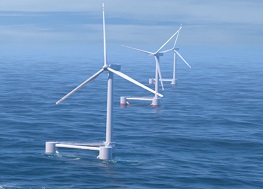Interest in developing marine renewable energy in U.S. waters is growing, and the marine spatial planning process being undertaken in the state of Washington seeks to align this use with other ongoing uses of ocean waters. In anticipation of potential proposals for marine renewable energy projects, the Washington State Legislature directed that the final MSP include a framework for coordinating state agency and local government review of proposed renewable energy projects requiring multiple permits and/or other forms of formal approval. This framework must provide for timely review of and action on renewable energy development proposals while ensuring protection of sensitive resources and minimizing impacts to other existing or projected uses in the area (RCW
43.372.040).
Relevant Information
Energy Specific Information
For specific information about shipping, including a summary and future forecast for containers, breakbulk, grain, dry bulk, and liquid bulk cargo, read the full Sector Analysis Report on marine renewable energy.
Definition of the Sector
For purposes of this report we define marine renewable energy to include offshore wind,
wave, and tidal energy generation. A variety of devices may fall into these categories.
For example, offshore wind devices may include floating platforms, monopole structures,
or tripod/jacket devices, while wave energy devices tend to vary depending on the depths
at which they are designed to operate (Van Cleve et al. 2013).
History, Trends, and Opportunities
Marine renewable energy is an emerging use of ocean space. As noted in a recent report,
“[t]he marine renewable energy industry is still very young due to limited deployment
experience” (Van Cleve et al. 2013). While there have been expressions of interest in
marine renewable energy and some activity in this sector in the past along Washington’s
Pacific Coast (see below), there are no marine renewable energy projects currently in
operation in the study area, nor are any currently in development.3 The situation is
similar elsewhere in the United States; few if any projects have reached the development
phase, let alone the commercialization phase. The same report notes, “[a]ll of the
projects in the United States to date are pre-commercial or demonstration projects the
primary purpose of which is to test and validate new or innovative uses of technology or
combinations of technologies” (Van Cleve et al. 2013).
History
As noted above, there have been attempts in the past to develop marine renewable energy
off of Washington’s Pacific coast. The most prominent example is the Makah Bay
Offshore Wave Pilot Project, which received initial approvals from both the Federal
Energy Regulatory Commission (FERC) and the Olympic Coast National Marine
Sanctuary (OCNMS).
In November 2006, AquaEnergy, Ltd. filed an application for a license to construct,
operate, and maintain the 1.0-megawatt (MW) Makah Bay Offshore Wave Pilot Project,
to be located about 1.9 nautical miles offshore of Waatch Point in Clallam County (FERC
2007). The project as planned would have generated enough electricity to supply a
minimum of 150 homes (Thomas 2007). The proposal called for installation of four wave
energy conversion buoys (“AquaBuOYs”), a 3.7 mile long submarine transmission cable,
a shore station at Hobuck beach, and a transmission line to connect to the existing
Clallam County Public Utilities District (PUD) distribution line (FERC 2007). The PUD
had agreed to purchase power from the project (Thomas 2007).
The license requested was for a five-year project to demonstrate the economic and
environmental benefits of wave energy conversion power plants near coastal
communities, as well as to help further development of clean, renewable energy
technologies. A conditioned original license was issued to Finavera Renewables Ocean
Energy Ltd. (formerly AquaEnergy Ltd.) by FERC in December 2007. The FERC
license states:
“The project will occupy about 1 acre of land on the Makah Indian Reservation and
about 28.3 acres of lands, collectively, of the Olympic Coast National Marine
Sanctuary (Olympic Coast Sanctuary) administered by the U.S. Department of Commerce, National Oceanic and Atmospheric Administration (NOAA); and state-owned aquatic lands administered by teh Washington State Department of Natural Resources (Washington DNR). The project will generate an average of about 1,500 megawatt-hours (MWh) of energy annually” (FERC 2007).
In addition to the FERC license, the OCNMS issued AquaEnergy/Finavera a permit for a
pilot project to conduct research to support a future application for installation of an
alternative energy project (Personal comm. G. Galasso 2014). This permit approval was
based on the involvement of the Makah Tribe, which has lands adjacent to the Sanctuary.
According to the Seattle Times article, the Makah Bay project was the country’s first wave-energy project to receive an operating license, but experienced delays in receiving necessary state and federal environmental permits (Ma 2008). In addition, the developer experienced difficulties finding investors for the project (Thomas 2007). In 2008 the developer decided to hault all wave-energy projects and focus instead on wind power; thus, the project was never completed (Ma 2008).
Trends in Washington State
Washington is one of the nation’s top producers of electricity from renewable resources; in 2010, renewables accounted for more than 72 percent of the electricity produced statewide. As illustrated in the diagram below, the majority of this production came from conventional hydropower projects, which accounted for 66 percent of the state’s net electricity generation (EIA 2012). Most hydropower production occurs along the Columbia River, which features hydroelectric projects such as the 6,809 megawatt capacity Grand Coulee Dam (EIA 2014). Non-hydroelectric renewable energy resources provided just over six percent of Washington’s net electricity generation, with wind accounting for 4.6 percent, wood and wood waste accounting for 1.6 percent, and landfill gas accounting for 0.2 percent (EIA 2012). Among non-hydroelectric renewable energy resources, wind power serves as the state’s largest electricity generator. Washington currently has an installed capacity of approximately 2,800 MW of wind power, placing it ninth among states nationwide (AWAE 2014).
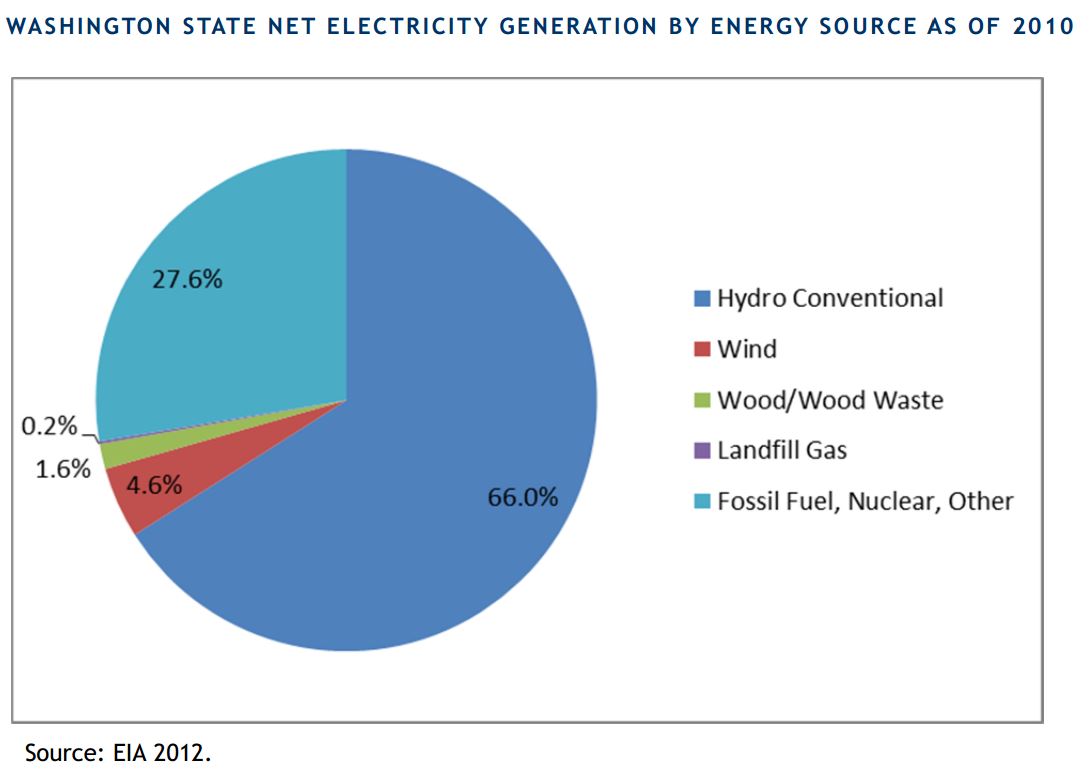
Development of terrestrial wind power is continuing in wind-intensive areas such as the Columbia River Gorge. Recently, however, terrestrial wind development has slowed, with only one new project starting construction in 2013 (Sickinger 2014). One stakeholder suggests that this may be indicative of a longer-term trend, and that offshore wind resources will become more competitive in approximately 20 years, once the best terrestrial wind sites are fully developed (Personal comm. T. Stearns 2014). A number of other factors have also contributed to the slowing development of wind power in the Northwest (Sickinger 2014).
Specifically:
- Utilities in Washington and Oregon have satisfied early requirements under their states’ renewable portfolio standards (RPS).
- California has banned the use of out-of-state sources to meet its RPS, lessening demand from that state.
- A federal production tax credit that supported the development of wind energy expired at end of 2012, and was not reinstated until late in 2013.
Regional Developments
Although there are no marine renewable energy projects currently in operation or development within the study area, there are a number of projects at various stages of licensing and development in the Pacific Northwest. Most notably, these include a tidal energy project in the Puget Sound area of Washington and an offshore wind energy project off of Coos Bay, Oregon. In addition, the Bureau of Ocean Management (BOEM) has approved a wave energy test site in Oregon. Each of these projects is discussed below.
Admiralty Inlet Tidal Project, Puget Sound, Washington
In 2012, the Snohomish County PUD filed a license application with FERC for the Admiralty Inlet Pilot Tidal Project. This U.S. Department of Energy (DOE) funded project represents approximately $10 million of federal investment. Field measurements in this location are ongoing, making this the best characterized tidal site in the United States (DOE 2013). The plant will consist of two horizontal-axis tidal turbines connected to the grid near Admiralty Head on Whidbey Island via two subsea cables. FERC released an “Order Issuing Pilot License” on March 20, 2014 (FERC 2014a). The PUD has continued pursuing other required federal, state, and local permits, and is nearing final detailed engineering design for the project. Preliminary preparation work on shore and installation of underground transmission cables will begin in spring/summer 2015, and deployment of the turbines into the water in summer 2016. Under the FERC license, the turbines will be removed following three to five years of operation (Snohomish PUD 2014, FERC 2014a). The National Oceanic and Atmospheric Administration (NOAA) is working with the PUD, the Northwest Fisheries Science Center and the Northwest National Renewable Energy Marine Center (NNMREC) at the University of Washington (UW) to determine appropriate monitoring protocols and mitigation measures for this project (NOAA 2014).
WindFloat Pacific off Coos Bay, Oregon
Principle Power, Inc. is developing its WindFloat Pacific project off Coos Bay, Oregon. The project is the first offshore wind farm proposed for the West Coast of the United States, and the first in the nation to use a floating structure to support offshore wind generation. The project will be sited 18 miles offshore, within a 15 square-mile area of 1,200-foot deep water out of sight from land. The project is designed to generate electricity from five floating “WindFloat” units, each equipped with a six MW offshore wind turbine. The WindFloat system will be assembled on shore and towed out to sea, mitigating the need for costly vessels typically used to assemble offshore wind systems at sea. The turbines will be connected by electrical cables and have a single power cable transmitting the electricity to shore. The cable will make landfall on industrial land at Port of Coos Bay (Principle Power 2014). This project received strong support from potential economic development partners and cooperation from a broad range of federal and state regulatory agencies involved in the approval process (Personal comm. A. Weinstein 2014).
Principle Power Inc. submitted an unsolicited request to BOEM for a commercial wind energy lease in May 2013 as an initial step in the leasing process. In February 2014, BOEM issued a determination of no competitive interest for the proposed lease area, and is proceeding with a non-competitive lease issuance. Principle Power, Inc. has received two rounds of DOE funding: (1) in December 2012, DOE awarded $4 million for its advanced technology demonstration project, and (2) on May 7, 2014, DOE selected the WindFloat Pacific project to receive a matching grant of up to $47 million over the next four years to accelerate development of the project (Principle Power 2014a). The next steps will be to prepare an Environmental Impact Statement (EIS) as part of the National Environmental Policy Act (NEPA) process. The full permitting process will also include consultations with the NOAA’s National Marine Fisheries Service (NMFS) under the Endangered Species Act and Marine Mammal Protection Act, as well as interactions with agencies such as the U.S. Army Corps of Engineers, and the U.S. Coast Guard (Principle Power 2014).
Principle Power estimates that the project will attract more than $200M in federal and private investment into the Northwest economy (Principle Power 2014). The company believes the project will become a driver for a new maritime industry involving manufacturers, ports and shipyards involved in engineering, naval architecture, research and offshore operations and maintenance related to the offshore wind industry (Principle Power 2014).
North and South Energy Test Sites, off Newport, Oregon
With funding from DOE, NNMREC at Oregon State University (OSU) is developing the first utility-scale grid-connected wave energy test site off of Newport, Oregon. NNMREC is a partnership between OSU and the UW, focused on wave and tidal energy respectively, and receives a substantial part of its funding from DOE. NNMREC operates several sites for wave energy testing with a goal of creating a global hub for marine renewable energy development. For intermediate scale wave energy devices, UW supports open water testing in Puget Sound and in Lake Washington. For a full scale wave energy resource, the North Energy Test Site (NETS) can accommodate devices up to 100kW connected to the Ocean Sentinel, and larger devices if no grid emulation or connection is required. NETS is one square nautical mile, located between two to three nautical miles off the coast near Newport, Oregon, north of Yaquina Head. The site has depths of 45 to 55 meters, and opened in the summer of 2012. The grid-connected site currently under development off Newport, Oregon, will be referred to as the South Energy Test Site (SETS). SETS will serve as the utility-scale wave energy test facility for the United States, and is expected to be available for device testing in 2016. SETS depth range will be 55 to 70 meters (OSU 2013). After conducting a public input process, to determine whether it was appropriate to issue a lease on a non-competitive basis, BOEM published notice of determination of no competitive interest for the SETS facility on March 24, 2014 (79 FR 16050).
Opportunities
Given the technological issues faced by this nascent industry, the likelihood of development of marine renewable energy off Washington’s Pacific coast in the foreseeable future (i.e., 20 years) is limited. Development of tidal energy is highly unlikely as there are few suitable locations with adequate tidal velocity (Van Cleve et al. 2013). Tidal resources within the study area are limited to Willapa Bay, where the channel is so narrow it would limit the size of an array to such an extent that it would not be economically feasible (Personal comm. B. Polyage 2014). Wave energy development is also highly unlikely to be developed in the study area in the next 20 years, as conversion devices are still in the early stages of development. Technology developers must solve the issue of survivability in harsh ocean conditions before wave energy can be developed commercially; testing of devices off the coast of Oregon is now underway (Personal comm. B. Polyage 2014).
Based on discussions with stakeholders, the consensus is that the best opportunities for marine renewable energy projects within the study area are in offshore wind, but the likelihood of development in the foreseeable future is unclear. Some industry representatives do not believe there will be attempts to develop marine renewable energy along the Washington coast within the next 20 years (Personal comm. A. Weinstein 2014). Along the northern coast, development is unlikely for two reasons: (1) restrictions on energy development in the OCNMS, and (2) limited transmission infrastructure. In the southern half of the study area (below the OCNMS), sufficient transmission infrastructure is available, but this area has heavy shipping traffic and is more shallow due to sediments from the Columbia River, which could make siting difficult for the use of floating platforms for offshore wind (Personal comm. A. Weinstein 2014). Stakeholders also cited the Seventh Power Plan currently being developed by the Northwest Power Planning Council, which indicates marine renewable resources are not likely to be competitive in the 20-year timeframe being considered here (Personal comm. B. Polyage 2014).
In addition, there are mixed feelings about the opportunities for small scale projects. Some experts felt there is potential that small distributed or community-based power generation similar to the project proposed for Makah Bay could occur in the near future (i.e, within 10 to 15 years) (Personal comm. PNNL 2014). Others felt that given current issues with survivability, these types of wave energy projects are unlikely to be developed in the foreseeable future (Personal comm. B. Polyage 2014).
Despite these challenges, there are incentives for the development of renewable energy projects off Washington’s Pacific coast. Several factors may make expansion into offshore wind attractive, including the state’s renewable portfolio standard (RPS) and the availability of federal grants (ACORE 2013). The state’s RPS, passed in 2006, requires all utilities serving more than 25,000 customers (85 percent of the state’s electric load) to obtain at least 15 percent of their electricity from new renewable resources by 2020 (DSIRE 2014). To date, the state is only about one-third of the way towards this goal (Personal comm. T. Stearns 2014). Federal funding for marine renewable energy projects is available through various Department of Energy programs and matching grants (DOC 2014, Navigant 2013a). Given RPS goals and the history of past proposals, interest in the development of wind and other renewable energy projects off Washington’s coast may grow more quickly than anticipated.
Several other factors related to the likelihood of opportunities for marine renewable energy in the study area are addressed below. These factors include the suitability of the study area for such projects and the potential economic benefits to be gained from their development.
Suitability of the Study Area
Under a previous contract with DNR, in support Washington’s MSP process, Pacific Northwest National Laboratories (PNNL) developed a marine renewable energy suitability data layer to evaluate certain aspects affecting feasibility of marine renewable energy development off Washington’s coast (Van Cleve et al. 2013). The objective of this analysis was to identify the suitability of large zones for potential development, rather than to evaluate the feasibility of developing individual project sites. PNNL’s suitability analysis does not consider the full set of economic, social, legal, regulatory or environmental factors that would need to be considered to determine the feasibility of a particular project. Instead, suitability ratings are based on site quality factors, including:
- Minimum and maximum site depth;
- Bottom sediment type;
- Energy resource potential (wind, wave, and tidal); and
- Distance to shore, transmission lines, substations, ports and airports, and shoreside support
The analysis developed maps for eight types of tidal, wave and wind devices. In general, PNNL found that the southern half of the Washington coast had a wider range of sites with higher suitability scores than the north coast (north of Taholah). The primary factor driving this pattern is grid connectivity (Van Cleve et al. 2013).
Another geospatial database, The Nature Conservancy’s (TNC) Washington Marine Planner, looks at the suitability of areas for marine renewable energy. TNC, in partnership with Ecotrust, has developed GIS layers that score areas based on their suitability for the development of wind power, tidal power, and wave power (TNC 2014). The scores for an area are based on energy potential, substrate or sediment type, depth range, distance to electrical substations, and distance to electrical transmission lines. The scores indicate that large portions of the study area offshore of the Washington coast are suitable for wind or wave energy development, while tidal energy development potential is very limited. Based on a scoring system where zero indicates least suitable and ten is most suitable, large areas offshore of the Washington coast appear suitable for wind and wave power (receiving a score of seven or higher). For tidal power, very few areas appear at all suitable, with only limited areas in Grays Harbor and Willapa Bay receiving scores from two to four (TNC 2014).
In addition, various market assessments have been produced for DOE considering the potential resources available for wind, wave, and tidal power throughout the United States.
- In 2010, the National Renewable Energy Laboratory (NREL) assessed wind power resources throughout the United States. This report indicates Washington has significant offshore wind resources, with total potential of 121 gigawatts (GW) over 24,193 square kilometers of area within 50 nautical miles of shore that have annual average wind speed of greater than seven meters/second (NREL 2010).
- In 2011, the Electric Power Research Institute (EPRI) produced a mapping and assessment of wave energy resources throughout the United States; results are presented by state. Washington has significant available wave energy resources,
estimated to be 116 Terrawatt-hours (TWh) per year along the outer shelf, and 72 TWh per year along the inner shelf (EPRI 2011). - In 2011, Georgia Tech created a national database of tidal stream energy potential, as well as a GIS tool usable by industry in order to accelerate the market for tidal energy conversion technology. This report found limited theoretical available power from tidal streams within the study area, with only 61 megawatts (MW) at Grays Harbor and 91 MW at Willapa Bay (Georgia Tech Research Corporation 2011).
Potential Economic Benefits of Offshore Wind
Development of offshore wind resources can drive substantial employment and other economic impacts such as investment, output, and value added. As part of the first annual analysis of the U.S. offshore wind market prepared for DOE, the Navigant Consortium forecast potential economic impacts of future offshore wind development through 2030 for the United States. To conduct this analysis, Navigant employed input-output models developed by NREL known as the JEDI models (for Jobs and Economic Development Impacts). The JEDI models project employment and investment impacts related to energy development projects, including offshore wind, biofuels, coal, solar photovoltaic, marine/hydrokinetic power, and other energy sources. To forecast economic impacts, the offshore wind model requires detailed cost input assumptions for the construction and operation of energy projects. In addition, model users must estimate the percentage of each expenditure line item that is acquired locally. Navigant employs the JEDI model to analyze three scenarios of offshore wind development in the United States: (1) high growth with 54 gigawatt (GW) capacity by 2030, (2) moderate growth with 28 GW capacity by 2030, and (3) low-growth with 10 GW capacity by 2030. The diagram below shows the projected employment and economic activity impacts for the three development scenarios.
The economic impacts shown reflect direct, indirect, and induced effects of the offshore wind deployment scenarios. Under these scenarios, by 2030 the offshore wind industry could produce substantial economic activity totaling $10 billion to $70 billion and associated employment from 50,000 to 350,000 FTEs, depending on the scenario.
Annual Employment and Economic Activity Supported by Potential U.S. Offshore Wind Development
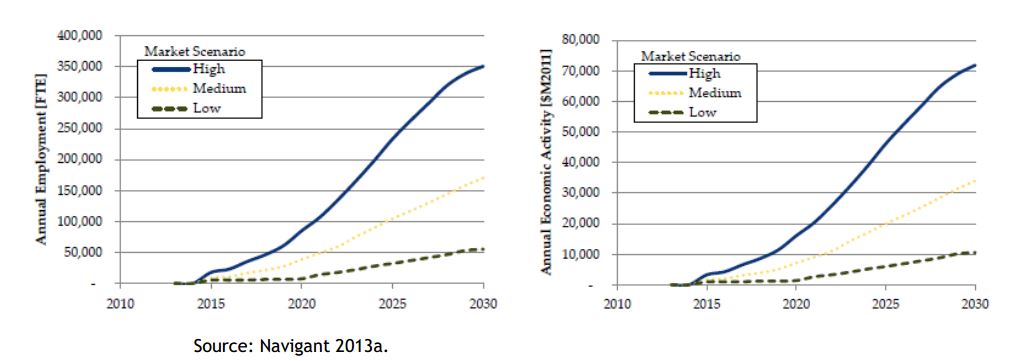
In addition to forecasting employment and economic activity impacts for different deployment scenarios for the United States, Navigant also estimates impacts for the development of a single offshore wind plant in the North Atlantic. Navigant estimates construction and operation costs for a 500 MW offshore wind plant that would be completed in 2018. The JEDI outputs suggest that plant construction could support 3,500 job-years and drive $652 million in local spending during the construction period. The model also estimates that plant operations could support 284 jobs and $50 million in spending for each year of the plant’s operating life. The diagram below provides a detailed look at the economic impacts resulting from plant construction and operation.
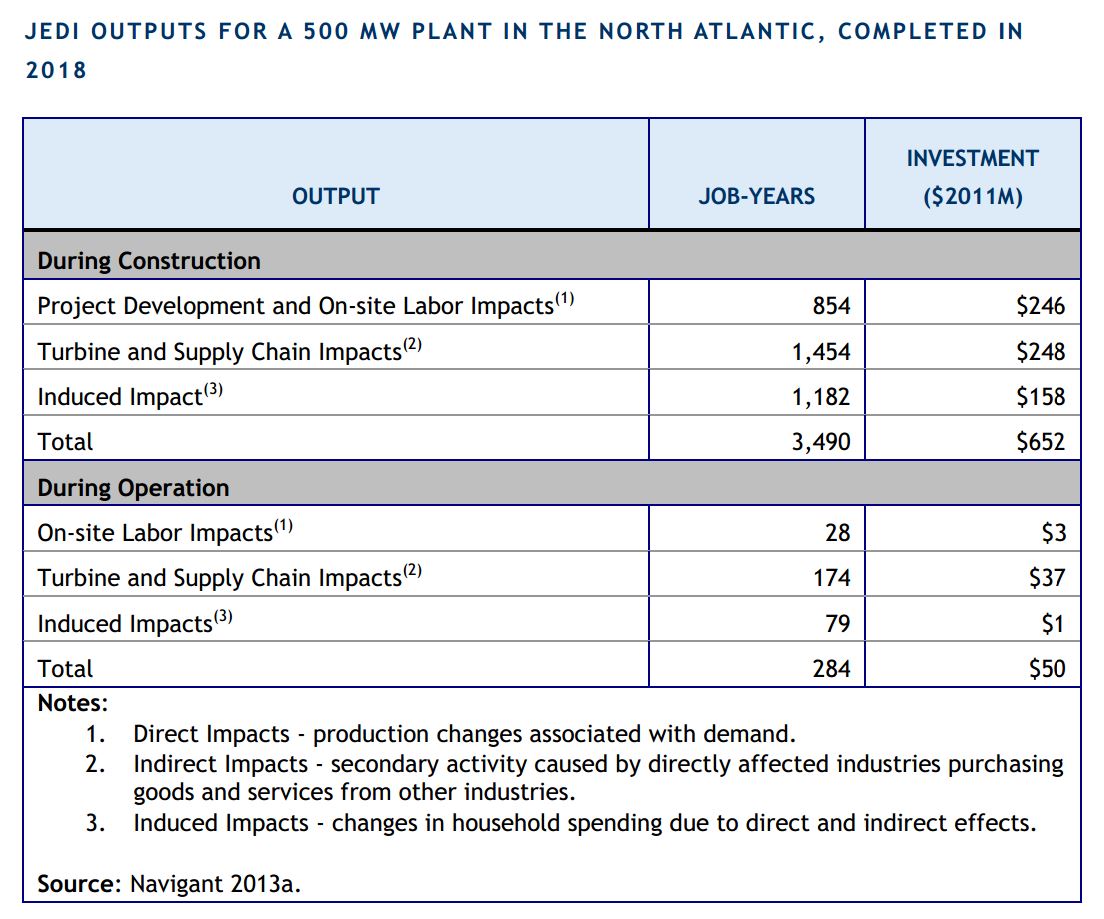
In a similar analysis, IHS Emerging Energy Research estimates the economic impacts of developing 7,700 MW of offshore wind capacity across four Mid-Atlantic States (NJ, DE, MD, and VA). The scope of this analysis falls between Navigant’s two analyses of the single North Atlantic plant and the full-U.S. deployment scenarios. Based upon detailed cost estimates for the construction and operation periods for the 7,700 MW offshore wind development, IHS uses input-output models to estimate economic impacts in terms of employment, labor income, value added, and output. The diagram below summarizes the projected economic impacts for the construction period (10 years) and the operation period (annual) of the offshore wind farm development. An offshore wind development of this magnitude would create substantial economic impacts. Over the ten-year construction phase the development would be expected to create value added of $16 billion and nearly 150,000 jobs. During operations, expected economic impacts include total value added of $1.1 billion and approximately 9,000 jobs annually (IHS 2012).
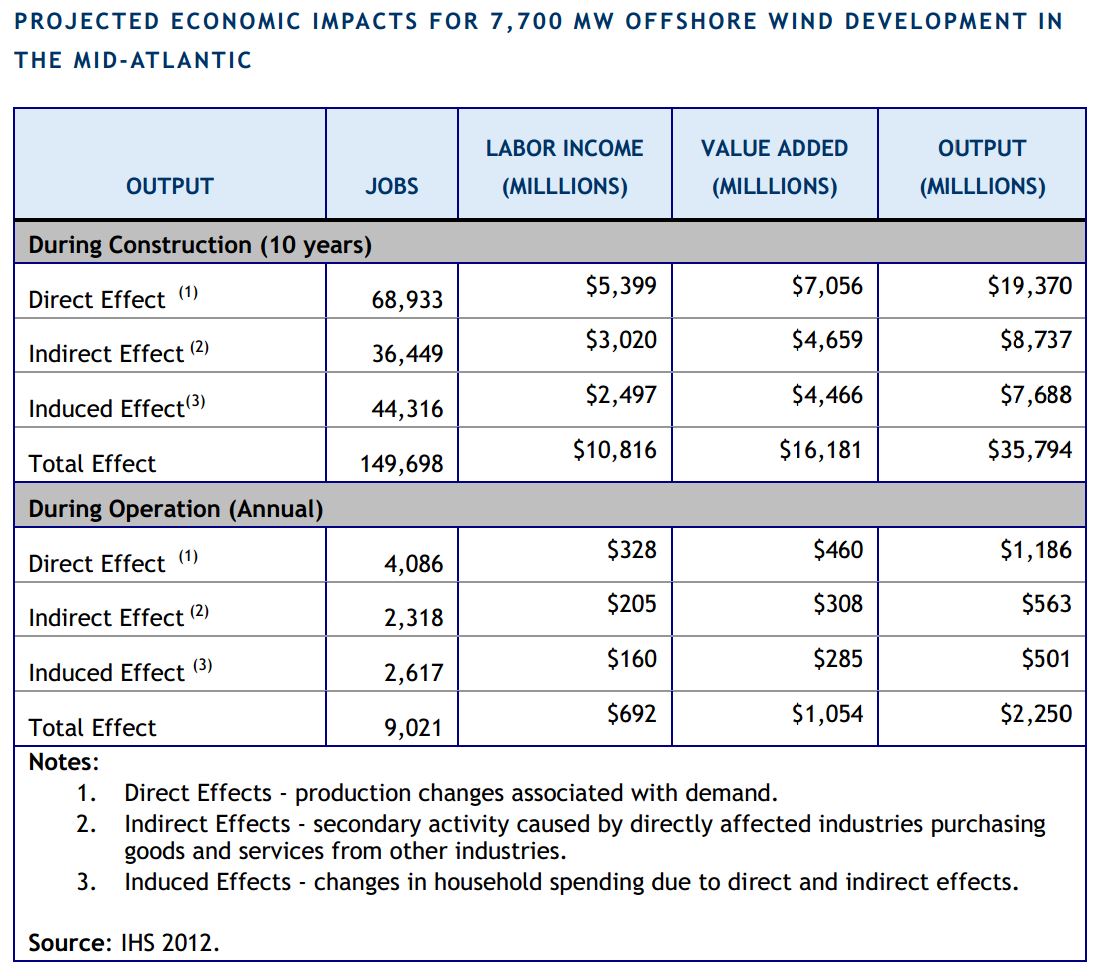
Finally, Principle Power provided estimates of the economic impacts of its WindFloat pilot project (off of Portugal). This project cost roughly $27.2 million (USD) and employed over 200 people (Personal comm. A. Weinstein 2014).
Summary of Key Issues
Industry experts identified a number of key issues confronting the marine renewable energy sector in the short and longer term. These issues generally fall into five categories: market factors, infrastructure availability, regulatory uncertainty, conflicts with other uses, and environmental concerns. The impact of these issues on the development of the marine renewable energy sector is discussed in greater detail in the full marine renewable energy sector analysis report.
| Issue | Concerns |
| Market factors |
|
| Infrastructure availability |
|
| Regulatory uncertainty |
|
| Conflicts with other uses |
|
| Environmental concerns |
|
Key Questions and Data Gaps
Given the status of the marine renewable energy sector as an emerging industry, relatively little economic information on the industry is available. In addition, as no marine renewable energy projects have been developed to date in the study area, there are no data available specific to the study area. Relevant data at the state, national and global level do exist to provide context for the industry, as highlighted in Exhibit 4-1. In particular, the 2013 Offshore Wind Market and Economic Analysis provides a solid overview of the industry. In addition, the geospatial analyses developed by PNNL and TNC provide information related to the suitability of the study area for marine renewable energy (Van Cleve et al. 2013, TNC 2014).
Key questions concerning the economics of the industry include:
- What types of limitations might be placed on marine renewable energy projects, with respect to exclusion zones or mitigation for environmental concerns?
- What is the process and prescribed timeline for obtaining the necessary regulatory approvals, permits and licenses?
- When might electricity prices and/or development costs shift enough to make offshore wind more cost-competitive?
Data to answer these questions are not currently available, but as the industry develops, regulators and the market will shift, and this information may become easier to obtain.
Energy Specific Information
For specific information about shipping, including a summary and future forecast for containers, breakbulk, grain, dry bulk, and liquid bulk cargo, read the full Sector Analysis Report on marine renewable energy.

